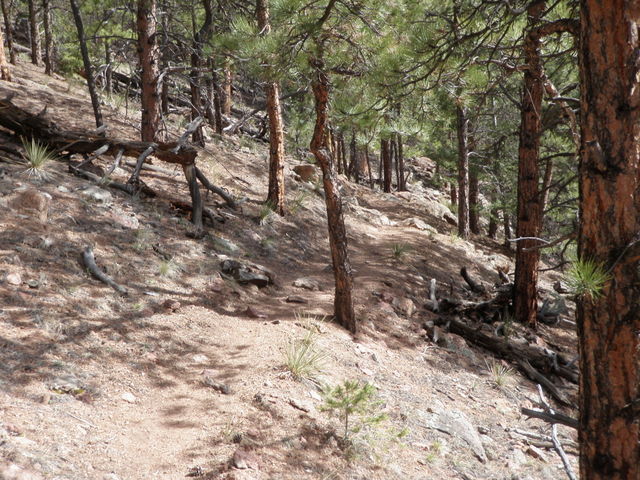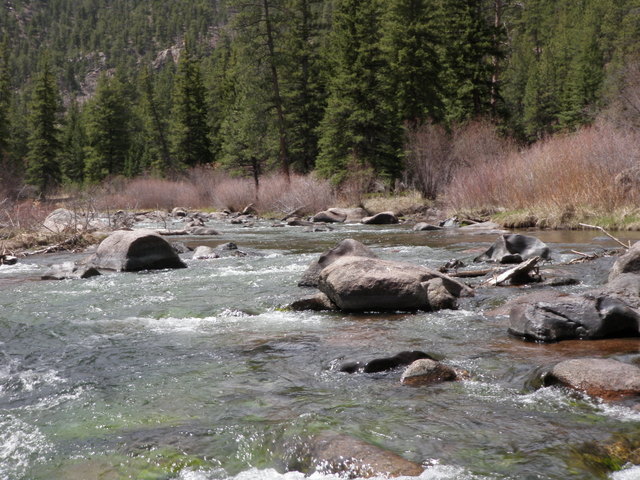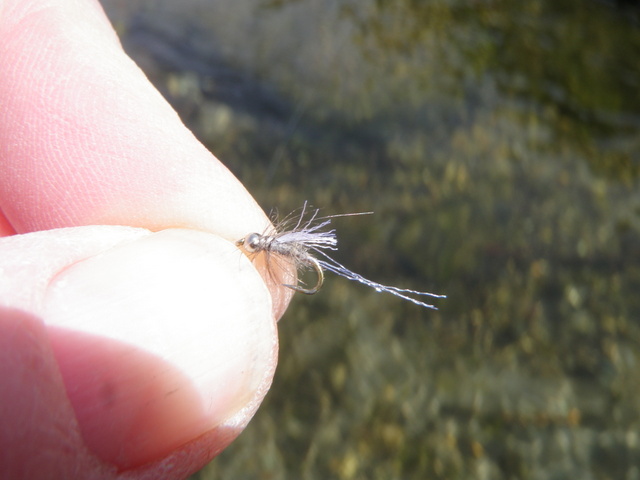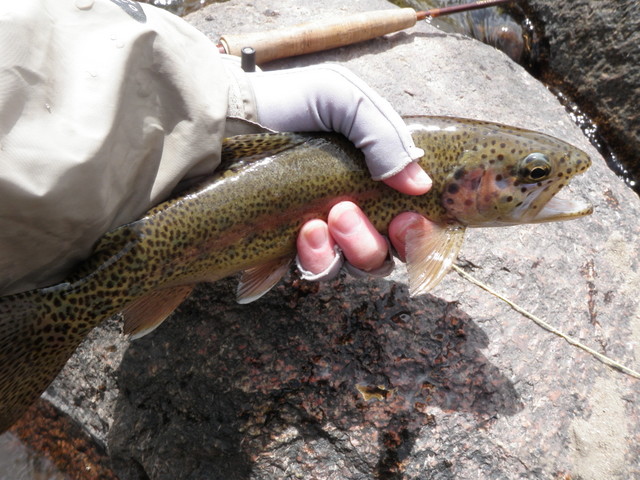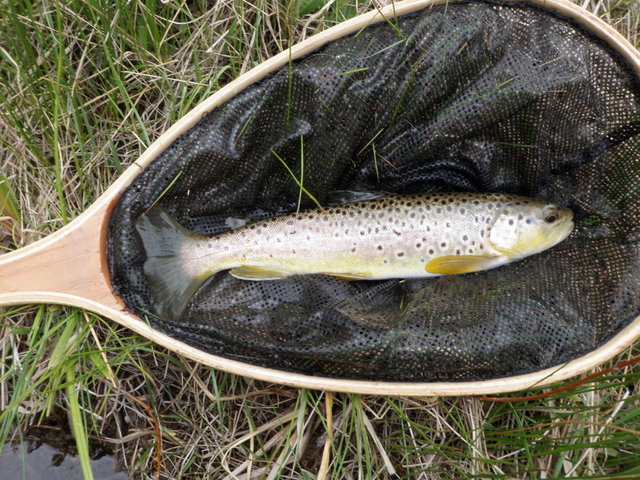Time: 10:30AM – 4:00PM
Location: Wildcat Canyon
Fish Landed: 21
South Platte River 05/16/2014 Photo Album
The Mothers’ Day snowstorm came and went, but the air temperatures remained unseasonably cold Monday through Thursday. I was depressed and feeling sorry for myself, as I was certain that the cold winter weather caused me to miss my last chance to stream fish in Colorado before the snowmelt bloated all the rivers and streams. But just for fun, I decided to check the DWR site and review the stream flows during the middle of the week. Much to my surprise, the cold temperatures halted the snow melt, and a number of streams within a day trip of Denver were at near ideal flows. I was positioned at work to take a day off, so I made plans for a fishing excursion on Friday.
All spring I had been considering a trip to the South Platte River in the Wildcat Canyon area. I’ve fished this gorgeous stretch of water ten or so times, but always after mid-August and never in the spring before the flows climb to difficult levels. I checked the flows on the South Platte River near Lake George, and they were 85 cfs, so this concluded my deliberations. Because this destination involves a hike in excess of one hour, I prepared everything on Thursday evening so I could get off to an early start. I even made a pack in fishing list on my iPhone so that I could assure myself that I would not forget any critical item when I packed for the three mile hike away from the car. I also made a list of all the flies I thought I might need and went through my front pack and fly boxes and added flies where I determined that I might be in short supply.
Everything worked as planned, and I left my house in Denver at 6:25AM. Denver traffic slowed me a bit, but I arrived at the trailhead by 8:45AM and the dashboard thermometer registered 39 degrees. I decided to wear my waders and wading boots for the three mile hike to the river in order to lighten the load on my back, and the cold morning temperatures reinforced that decision. I wore my fleece over my Columbia long sleeved undershirt and fishing shirt, and this proved to be a mistake. Once I was on my way, the intense exertion caused me to perspire quite a bit under the fleece layer.
I stopped at my usual staging area at 10AM after a one hour hike and rigged my fly rod and took off the fleece layer. I stuffed my lunch and raincoat in my fishing backpack and returned to the Platte Trail and hiked for another 15 minutes downstream until I reached the spot where the river narrows into a whitewater chute. I entered just above this point and tied on a Chernobyl ant and beadhead hares ear and began prospecting all the likely locations where trout might rest and feed. I failed to land the first couple fish that I hooked but eventually landed three or four on the hares ear.
The sky was clear and the sun warmed things up considerably at this point, but I covered some attractive water without any results so I tied on another section of leader and added a salvation nymph below the hares ear nymph. This combination broke my slump, and I added a couple more trout that hammered the salvation nymph.
By noon some large gray clouds moved above the canyon and blocked the sun, and some strong breezes kicked up. This development caused me to become quite chilled, and I thought it might rain, so I took time to remove my raincoat from my backpack and put it on over my clammy shirt. This helped for the time being, and now I was distracted by the appearance of some rises at the tail of a nice deep pool. Around this time I somehow created an enormous tangle, and in order to undo it, I removed both the subsurface flies. Before resuming, I decided to switch to a beadhead emerald caddis pupa and a small soft hackle emerger. I suspected the rises were in response to some early emerging blue winged olives, and my choice of the soft hackle emerger hopefully matched this food source. I’d also spotted a few random caddis on the water, so the emerald pupa hopefully covered this possibility.
These choices proved to be solid, and I landed four more fish primarily on the soft hackle emerger by 12:30PM. As this successful change in strategy was evolving, the sky grew darker and strong gusts of wind became a more frequent occurrence. My sun gloves had become saturated in the process of releasing fish, and now the cooling effect of evaporation was resulting in a dull ache and constant stiffness of my fingers. My feet were more like stumps as the feeling was draining from my toes, and the moist undershirt and fishing shirt were adding to my misery. I decided to return to my backpack and obtain another layer before proceeding.
When I arrived back at the staging area, I discovered two fishermen in the midst of resting, and they were eating their lunch. I chatted briefly with them, and dug into my backpack and pulled out my fleece and my New Zealand hat with ear flaps. Once these were secured on my body, I decided to eat my lunch before returning to my exit point. I sat by the stream and quickly consumed my snack while watching one of the fishermen enter the nearby pool and attempt to fool some sporadic risers with a dry fly. The young fisherman was unsuccessful in his endeavor, and I finished my lunch, so I bid them farewell and walked quickly down the path to my ending point prior to lunch.
I was much more comfortable when I entered the river, and the warm hat probably made the most difference. I continued prospecting the water with the Chernobyl ant, emerald caddis pupa and soft hackle emerger for the remainder of the afternoon and added another eleven fish to my total of ten before lunch. I spotted the occasional blue winged olive in the air, but the hatch was quite sparse. Fortunately this did not seem to hinder the fish from being on the lookout for the tasty tiny morsels that drifted in the water column as I landed most of my fish on the soft hackle emerger.
As I’ve stated previously in this blog, I relish this sort of fishing. I moved quickly up the river and popped three to five casts in all the likely pockets, runs and pools and picked up fish on a regular basis. It didn’t take long to discover that the most productive areas were deep troughs at the very tail of pools where two currents merged. If I allowed the flies to drift beyond the point where I normally would lift to cast again, a nice trout would often hammer the trailing soft hackle emerger. I tried lifting the flies when upstream or accelerating the drift via quick bad mends, but none of these techniques produced like the swing at the tail of a long pool.
Toward the end of the afternoon, I snapped the two subsurface flies off on a streamside willow on a backcast. I somehow was able to spot the two flies dangling in the air and retrieved them, but I used this as an opportunity to switch flies and converted to a dark olive deer hair caddis. The caddis brought a couple refusals and two or three momentary hook ups, but I was unable to land any fish with this surface fly. It was clearly close to what the fish were looking for, but perhaps off a bit in color or size.
By 4PM I was feeling quite weary from perhaps my longest extended period of constant wading and casting of the season to date, so I decided to call it quits. Despite the continuing colder than expected air temperatures and thick gray clouds, I shed all my layers down to my fishing shirt. I knew the exertion of hiking and climbing would elevate my body temperature, and I didn’t want to repeat the mistake of overdressing for the return hike. This strategy worked to some degree, but I was still quite perspired and exhausted when I reached the Santa Fe at 5:30.
Once again the remote stretch of the South Platte River yielded a fine productive day of fishing. I’ve had better days later in the season when my catch rate was higher, and the size of the fish were larger, but Friday was still a great experience particularly in the middle of May when I’m usually without good stream options. The allure of Wildcat Canyon is its remoteness and the solitude of having a gorgeous natural stretch of water essentially to myself. The fish aren’t large, but they are numerous and more opportunistic than the trout encountered in other highly pressured Colorado streams. If only the physical effort required for a day of fishing in this area weren’t so taxing, but this is probably the reason it remains wild and pristine and one of my favorite places.

